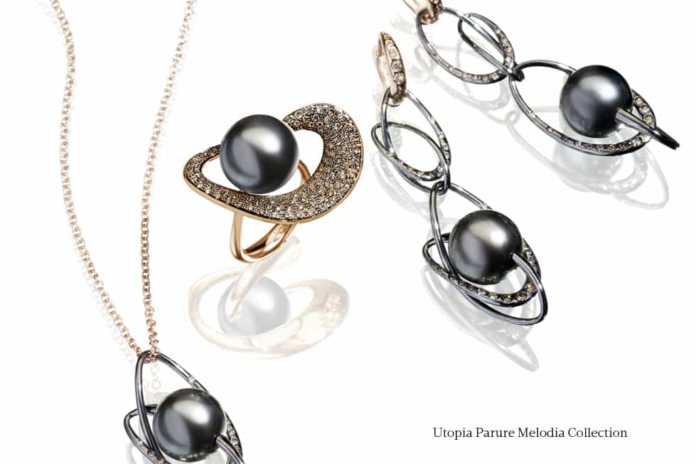
Any self respecting jewellery collection will include cultured pearls, and more often than not, in several forms.
by Duncan Parker
Pearls are a classic of the jewellery world. The size, shape, colour, or length of a necklace of pearls we seek and wear may change from time to time, but we continue to be attracted by these beauties of nature.
It’s likely that back in the day, people would save this shiny objects that came as a free gift in an occasional unmarked oyster. Pearls are really the only gems that come ready-to-wear, complete with a free meal.
These days, the pearl is less likely to be an accident of nature, and more the result of human intervention. The first decade of the 20th century saw the patenting of the process for culturing pearls in mollusks (oysters). With origins in Japan, we have assisted and encouraged oysters to grow these bright, shiny and somewhat mysterious beads for over a century.
Many varieties of mollusks are farmed to produce pearls and there is extensive breeding to produce the finest pearl in the sea around Japan, in the “South Seas,” including Tahiti and Australia, and in freshwater in China and the United States.
There are, occasionally, pearls found in nature without human intervention. The Persian Gulf is still fished for traditional natural pearls and there are some pearls that show up by pure good fortune in clams, conches, quahogs, abalones, and scallops. These rarities are the territory of collectors and there will never be an abundance of them.
The classic graduated cultured pearl necklace from grandma’s jewellery box has become something of a relic of history, often handed down to a blushing bride as “something old” or “something borrowed.” We really don’t see that kind of necklace being offered for sale these days. But this is not by any means a harbinger of the end of pearls as we know them.
Today, the fashion press is all over pearls. There have never been so many pearl jewellery pieces available as there are today. The culturing and marketing of pearls may have been straying away somewhat from the traditional source being Japan, but for the very finest Japanese cultured pearls, there is still a strong demand.
The 80s and 90s saw a spike in the demand for larger South Sea cultured pearls. Tahiti became the source for black and grey pearls and Australia became an important source for white South Sea cultured pearls. These places have served as significant sources of pearls for a long time, but they have also been heavily affected by improvements in freshwater cultured pearl production.
The freshwater pearl culturing industry in the U.S. has been around for decades but it has been fully eclipsed by Chinese freshwater cultured pearl farming.
China now has extraordinary production of freshwater cultured pearls, and through careful cultivation and hybridizing of species, the quality of the pearls is improving at an amazing rate.
We grade quality of pearls on a number of factors:
Lustre: Essentially, how shiny is the pearl? The shinier it is, the more valuable it is. Traditionally, freshwater cultured pearls have had a duller, perhaps more powdery-looking appearance, but this is changing. There are now several very bright freshwater pearls that almost approach in appearance the mirror-like lustre of the finest saltwater cultured pearls. This is partly a result of the growth, the mollusk, and the conditions, and partly the result of polishing (for both saltwater and freshwater pearls).
Size: The larger, the better. People generally gravitate toward large jewellery and South Sea and freshwater cultured pearls are being grown in very large sizes, sometimes over 20mm in diameter. Some people refer to the larger sized pearl as the “Wilma Flintstone” bead, just because they’re so big.
Colour: Traditional pearls range in shades of white and cream. There are many natural colours available and these are more valuable than dyed pearls, or artificially coloured pearls. Colours can be uniform in a necklace or blended into a rainbow according to taste and fashion.
Overtones: These are the secondary, iridescent colours seen reflected in the surface of a pearl and they are partly a result of diffraction through translucent layers. Freshwater pearls have traditionally been more opaque and don’t have strong overtones but this is also changing very fast.
Shape: Round pearls are more valuable than other shapes and are usually accompanied by their own names like “Coin,” “Fireball,” as well as many others. Non-round pearls are generally called “Baroque.” New and interesting shapes emerge regularly but round pearls remain to be the most popular.
Matching: Having the pearls match in a necklace strand or a pair of earrings remains to be a very important factor for consumers. Whatever piece of jewellery it may be, it’s more often than not that pearls need to match in all of their physical factors. As a result of this, some of the finest pearl necklaces ever created carry a hefty price tag because it can take years to build a collection of pearls that match across all factors.
Saltwater pearls are grown one at a time, and freshwater pearls are commonly grown in large numbers at a time in a single dinner-plate sized oyster. You can imagine; it might be easier to make a matched set of pearls if thirty of them all came from the same oyster at the same time.
As the quality and variety of freshwater pearls burgeons, the isn’t hard to see that pearls are continuing to make a very strong impact on world of fashion. Saltwater pearls are suffering market loss due to the comparatively modest price of their freshwater counterparts.
And while our grandmothers’ pearls will always hold a special place in our hearts, freshwater pearls will likely become the standard by which other pearls are evaluated. CJ
















